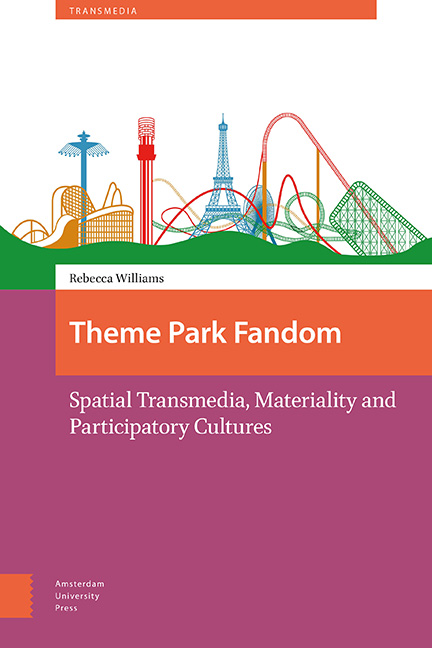Book contents
- Frontmatter
- Contents
- Acknowledgements
- 1 Introduction
- 2 Understanding the Contemporary Theme Park : Theming, Immersion and Fandom
- 3 Fandom, Brandom and Plandom : Haptic Fandom, Anticipatory Labour and Digital Knowledge
- 4 Extending the Haunted Mansion : Spatial Poaching, Participatory Narratives and Retrospective Transmedia
- 5 Of Mice and Minions : ‘Ani-embodiment’ and ‘Metonymic Celebrity’ in the Theme Park Character Encounter
- 6 Turkey Legs, Dole Whip and Duff : Consumables, Diegetic Paratexts and ‘Cult-Culinary’ Objects
- 7 Embodied Transmedia and Paratextual-Spatio Play : Consuming, Collecting and Costuming Theme Park Merchandise
- 8 Replacing and Remembering Rides : Ontological Security, Authenticity and Online Memorialization
- 9 Conclusion: Ways Forward for Theme Park and Fan Studies
- Index
2 - Understanding the Contemporary Theme Park : Theming, Immersion and Fandom
Published online by Cambridge University Press: 20 November 2020
- Frontmatter
- Contents
- Acknowledgements
- 1 Introduction
- 2 Understanding the Contemporary Theme Park : Theming, Immersion and Fandom
- 3 Fandom, Brandom and Plandom : Haptic Fandom, Anticipatory Labour and Digital Knowledge
- 4 Extending the Haunted Mansion : Spatial Poaching, Participatory Narratives and Retrospective Transmedia
- 5 Of Mice and Minions : ‘Ani-embodiment’ and ‘Metonymic Celebrity’ in the Theme Park Character Encounter
- 6 Turkey Legs, Dole Whip and Duff : Consumables, Diegetic Paratexts and ‘Cult-Culinary’ Objects
- 7 Embodied Transmedia and Paratextual-Spatio Play : Consuming, Collecting and Costuming Theme Park Merchandise
- 8 Replacing and Remembering Rides : Ontological Security, Authenticity and Online Memorialization
- 9 Conclusion: Ways Forward for Theme Park and Fan Studies
- Index
Summary
Abstract
This chapter provides a history of the development and definition of the contemporary theme park, focusing on how Orlando, Florida developed into the world's theme park capital. It also sets out the key areas of literature that the book contributes to, including work on themed space and place, transmediality and convergence, fan spaces and pilgrimage, distinction and cultural value, and self-identity and narrative. The chapter notes that work on fans of specific destinations or places remains scarce, arguing for greater focus on this mode of place-based fandom, as well as proposing a turn towards academic study of the spatial elements of transmediality, and the concept of spatial transmedia.
Keywords: spatial transmedia, place-based fandom, transmedia, fan pilgrimage, fan tourism, theme park history
Introduction
The theme park has a long history that originates in amusement parks such as Coney Island in the United States and Denmark's Tivoli Gardens in Europe (Weinstein 1992; Davis 1996: Milman 2010; Wood 2017). Theme parks have been seen to differ from the amusement park via their use of ‘areas (i.e., ‘lands’) that focus on telling a story. Their environments include architecture, landscaping, stores, rides and even food to support specific themes’ (Geissler and Rucks 2011, pp. 127–8). It is also generally agreed that theme parks should appeal to the family, have a single admission price, and offer high levels of service, maintenance and cleanliness, and investment (Clave 2007; Geissler and Rucks 2011). They also require ‘some form of ambient entertainment (e.g., costumed characters, strolling musicians) […] [and] enough activities and entertainment to yield an average visitor length of stay of 5 to 7 hours’ (Geissler and Rucks 2011, pp. 127–8). The theme park should also have ‘a thematic identity, feature one or more themed areas, be designed as an enclosed space with guest-controlled access’ and ‘offer some form of entertainment, food services, and merchandise’ (Clave 2007 in Milman 2010, p. 221). Whilst some parks have a single theme (e.g. the LEGOLAND Park in Windsor, England or Parc Asterix in France) others, such as the Disney and Universal parks, offer a range of spaces or ‘lands’ representing a variety of different themes (e.g. the past, the future, fairy tales).
- Type
- Chapter
- Information
- Theme Park FandomSpatial Transmedia, Materiality and Participatory Cultures, pp. 41 - 66Publisher: Amsterdam University PressPrint publication year: 2020



